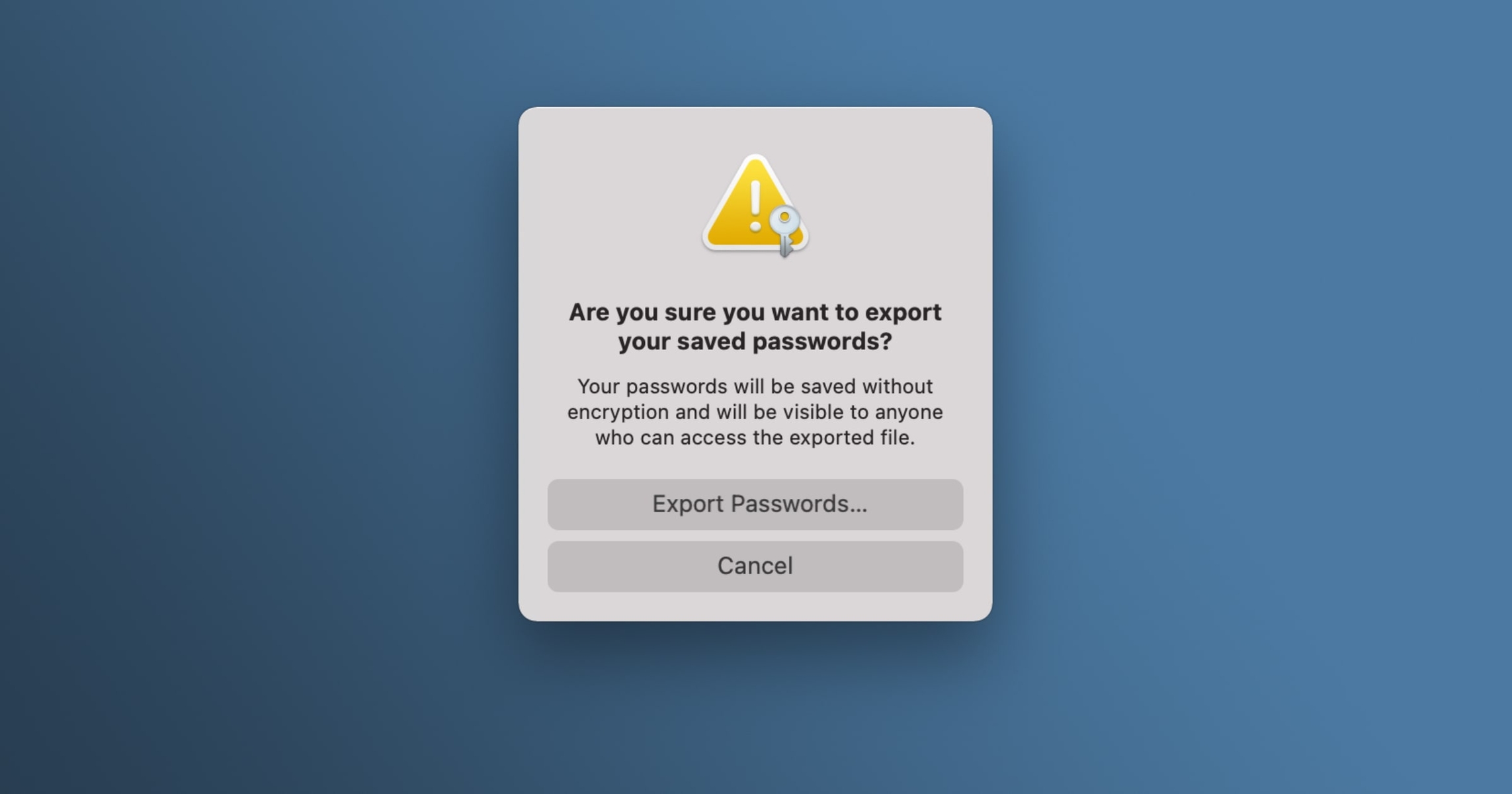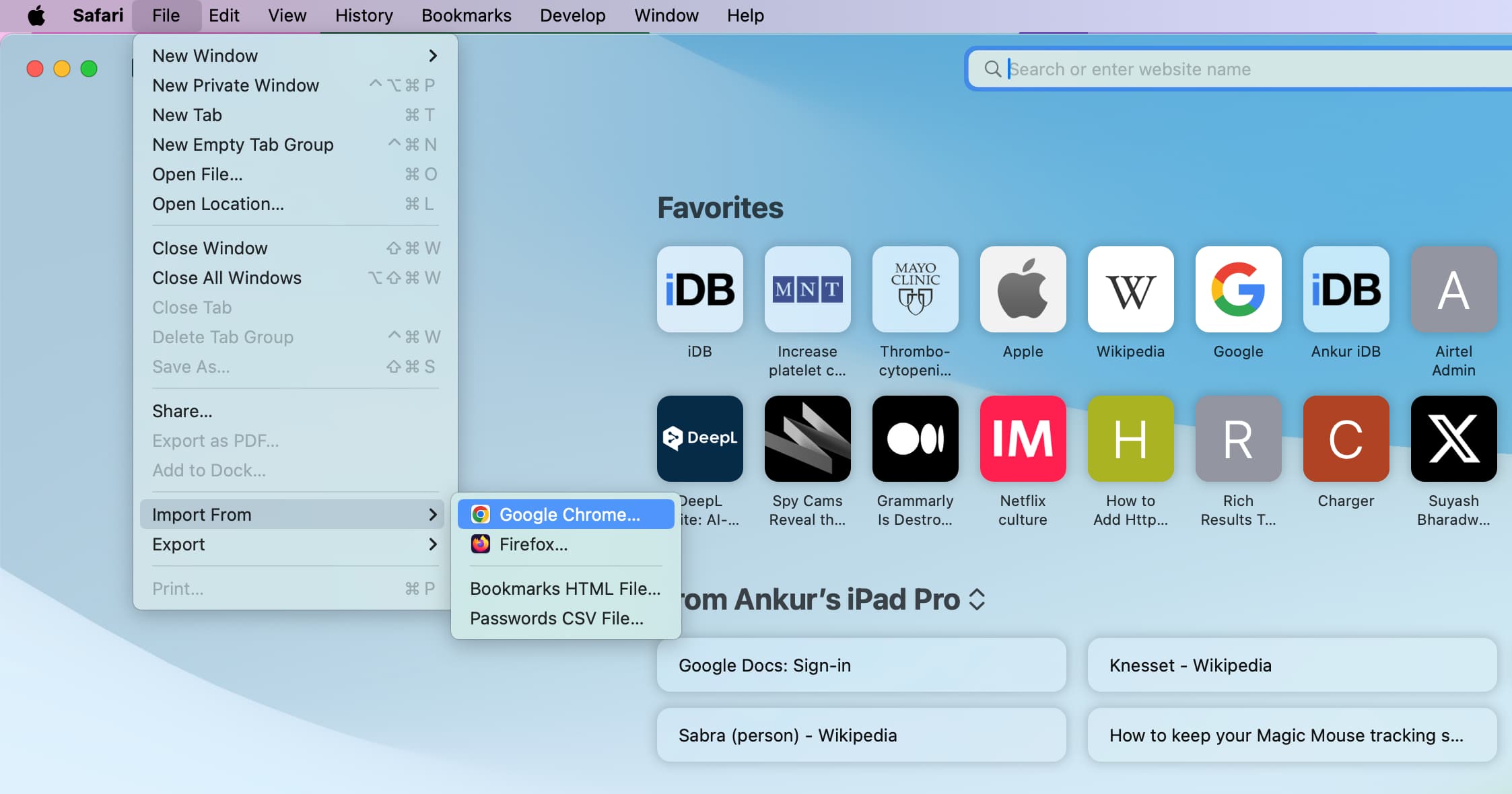Introduction
Safari, the default web browser for Mac, offers a seamless and secure browsing experience. One of its convenient features is the ability to store and manage passwords for various websites. However, there are instances when users may need to export their saved passwords from Safari. This could be due to the desire to switch to a different browser, the need to create a backup, or the intention to import the passwords into a password manager for enhanced security and organization.
In this guide, we will walk you through the process of exporting passwords from Safari on your Mac. Whether you're transitioning to a new browser, safeguarding your passwords, or simply exploring your options, understanding how to export your Safari passwords can be invaluable. By following the steps outlined in this article, you can efficiently export your passwords and ensure that they are accessible whenever and wherever you need them.
Let's delve into the step-by-step process of exporting passwords from Safari, empowering you to take control of your digital security and browsing preferences.
Step 1: Open Safari and Access Preferences
To begin the process of exporting passwords from Safari on your Mac, you first need to open the Safari browser. You can easily locate the Safari icon in your Applications folder or access it from the Dock. Once Safari is launched, navigate to the top-left corner of your screen and click on "Safari" in the menu bar. A drop-down menu will appear, and you should select "Preferences" from the options listed. Alternatively, you can use the keyboard shortcut "Command + ," to directly access the Preferences window.
Upon selecting "Preferences," a new window will open, presenting you with a range of customization and configuration options for Safari. This is where you can manage various settings, including privacy, security, and passwords. The Preferences window is divided into multiple tabs at the top, allowing you to navigate through different categories. To proceed with exporting your passwords, you will need to click on the "Passwords" tab, which is represented by a key icon. This tab is specifically designed for managing your saved passwords and related settings.
By accessing the "Passwords" tab, you will be able to view and manage the passwords stored by Safari. This includes the ability to view saved passwords, add new ones, and, of course, export the existing passwords. The "Passwords" tab provides a comprehensive overview of your stored credentials, offering a convenient way to organize and maintain your login information for various websites.
In summary, the first step in exporting passwords from Safari involves opening the browser and accessing the Preferences window. By navigating to the "Passwords" tab within the Preferences, you will gain access to the necessary tools and options for managing and exporting your saved passwords. This initial step sets the stage for the subsequent actions required to complete the password export process, empowering you to take control of your digital security and browsing preferences.
Step 2: Select the Passwords Tab
Upon accessing the Preferences window in Safari, you will be presented with a range of customization options, including the ability to manage your stored passwords. To proceed with exporting your passwords, navigate to the "Passwords" tab within the Preferences window. This tab, represented by a key icon, serves as the central hub for managing and organizing your saved login credentials.
When you click on the "Passwords" tab, you will be prompted to authenticate your identity using your Mac's system password. This additional layer of security ensures that only authorized users can access and manage the stored passwords. Once you have successfully authenticated, you will gain full access to the list of saved passwords, along with additional options for exporting and managing this crucial information.
Within the "Passwords" tab, you will encounter a comprehensive list of websites and corresponding usernames for which Safari has stored login credentials. This organized display allows you to easily locate specific entries and review the associated details. Each entry typically includes the website's URL, the username or email address used for the login, and an option to reveal the saved password.
In addition to viewing the stored passwords, the "Passwords" tab offers essential functionalities for managing this sensitive information. You have the ability to add new passwords, remove outdated entries, and edit existing credentials as needed. This level of control ensures that your stored passwords remain accurate and up to date, reflecting your evolving online activities and accounts.
Furthermore, the "Passwords" tab provides a seamless way to search for specific entries, making it effortless to locate and manage passwords for a particular website or service. This search functionality streamlines the process of identifying and exporting passwords, especially when dealing with a large number of stored credentials.
In summary, the "Passwords" tab within the Preferences window of Safari serves as a centralized platform for managing, organizing, and exporting your stored passwords. By selecting this tab, you gain access to a comprehensive overview of your saved login credentials, along with essential tools for maintaining and exporting this critical information. This pivotal step sets the stage for the subsequent actions required to efficiently export your passwords from Safari, empowering you to take control of your digital security and browsing preferences.
Step 3: Export Passwords
After accessing the "Passwords" tab within the Preferences window of Safari, you are now ready to proceed with the crucial step of exporting your stored passwords. Safari provides a straightforward method for exporting passwords, allowing you to create a secure backup or seamlessly transfer your login credentials to another platform or password manager.
To initiate the password export process, look for the "Export…" option within the "Passwords" tab. This feature enables you to generate a file containing your saved passwords, ensuring that you have a secure and accessible record of this vital information. Upon selecting the "Export…" option, Safari will prompt you to specify a destination for the exported file and choose a suitable file name. This level of customization ensures that you can conveniently organize and identify the exported password file according to your preferences.
Once you have designated the destination and provided a file name, Safari will prompt you to set a password for the exported file. This additional layer of security ensures that the exported passwords are safeguarded with an extra level of protection. By setting a password for the exported file, you can mitigate the risk of unauthorized access to your sensitive login credentials, thereby enhancing the overall security of the exported data.
After setting the password for the exported file, Safari will generate a file in the CSV (Comma-Separated Values) format, which is widely compatible with various applications and platforms. The CSV file contains a structured representation of your saved passwords, including the associated website URLs, usernames, and encrypted password data. This standardized format allows for seamless integration with password management tools and facilitates the secure import of your passwords into alternative browsers or dedicated password management applications.
Upon successfully exporting your passwords from Safari, you will have a secure and portable record of your saved login credentials. This exported file serves as a valuable backup, ensuring that you can access and restore your passwords in the event of unforeseen circumstances or when transitioning to a new browsing environment. Additionally, the ability to set a password for the exported file enhances the overall security of your stored passwords, aligning with best practices for safeguarding sensitive digital information.
In summary, the process of exporting passwords from Safari involves utilizing the "Export…" option within the "Passwords" tab, specifying a destination and file name, setting a password for the exported file, and generating a CSV file containing your saved passwords. This streamlined process empowers you to maintain a secure backup of your login credentials and facilitates the seamless transfer of passwords to alternative platforms or password management applications, ultimately enhancing your control over digital security and browsing preferences.
Conclusion
In conclusion, the process of exporting passwords from Safari on your Mac is a valuable capability that empowers you to maintain control over your digital security and browsing preferences. By following the step-by-step guide outlined in this article, you can efficiently export your saved passwords, ensuring that they are accessible whenever and wherever you need them.
The journey begins with opening Safari and accessing the Preferences window, where you navigate to the dedicated "Passwords" tab. This initial step sets the stage for managing and exporting your stored passwords, providing a centralized platform for organizing this critical information.
Upon selecting the "Passwords" tab, you gain access to a comprehensive overview of your saved login credentials, along with essential tools for maintaining and exporting this vital information. This includes the ability to add new passwords, remove outdated entries, and edit existing credentials as needed, ensuring that your stored passwords remain accurate and up to date.
The pivotal moment arrives when you initiate the password export process by utilizing the "Export…" option within the "Passwords" tab. This feature enables you to create a secure backup or seamlessly transfer your login credentials to another platform or password manager. By specifying a destination, providing a file name, and setting a password for the exported file, you ensure that your passwords are safeguarded and organized according to your preferences.
Ultimately, the process culminates in the generation of a CSV file containing your saved passwords, structured in a widely compatible format. This exported file serves as a valuable backup, ensuring that you can access and restore your passwords as needed, while the additional layer of security provided by setting a password for the exported file aligns with best practices for safeguarding sensitive digital information.
By mastering the art of exporting passwords from Safari, you gain the confidence to navigate the digital landscape with enhanced security and flexibility. Whether you're transitioning to a new browser, creating a secure backup, or exploring the integration of password management tools, the ability to export passwords from Safari empowers you to take control of your digital security and browsing preferences.
In essence, the process of exporting passwords from Safari on your Mac is not only a practical endeavor but also a strategic step towards fortifying your digital resilience and ensuring seamless access to your vital login credentials.

























